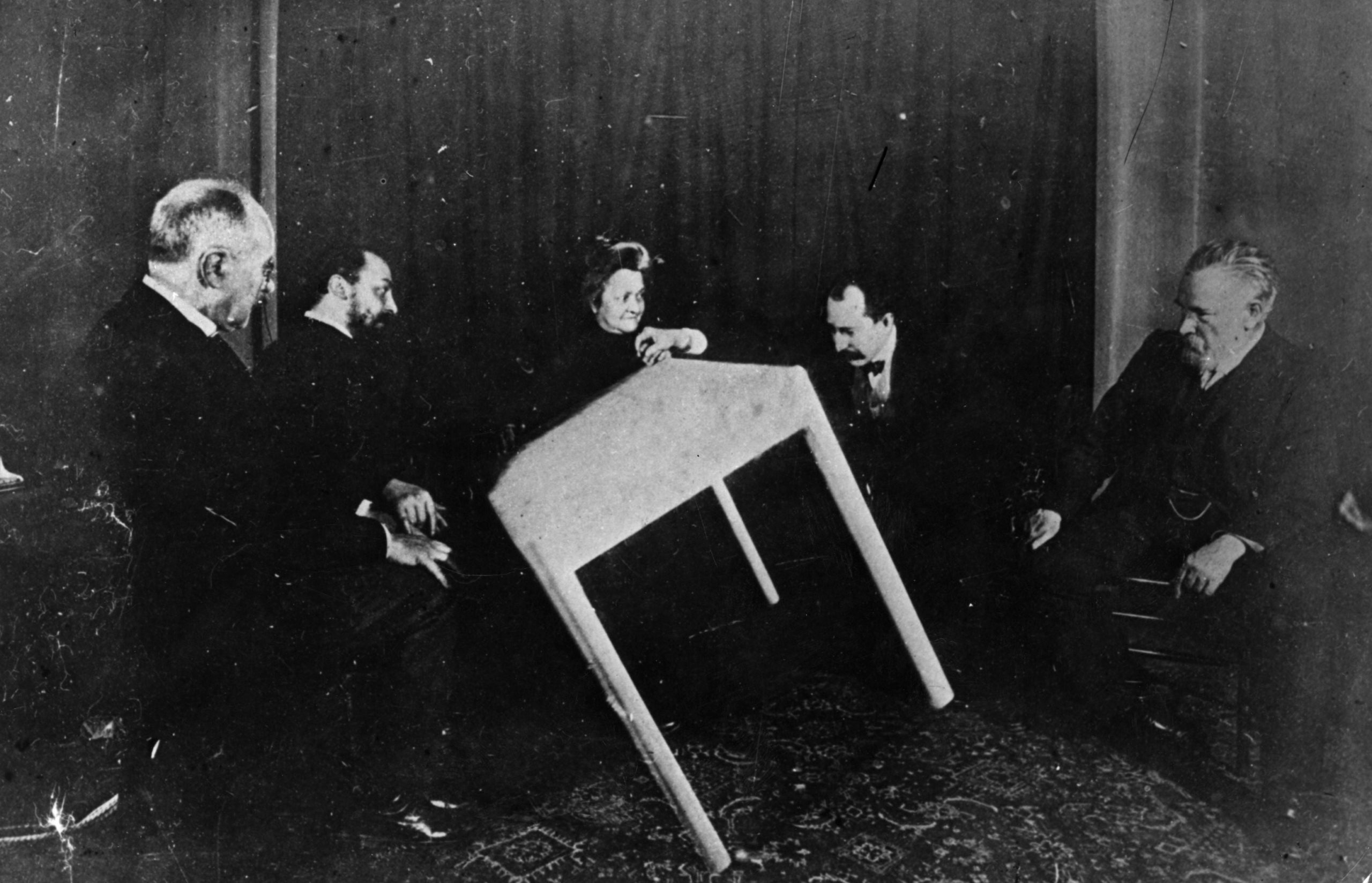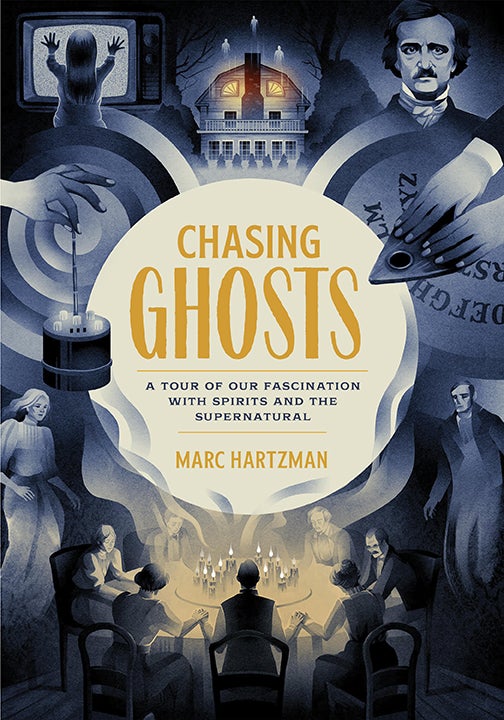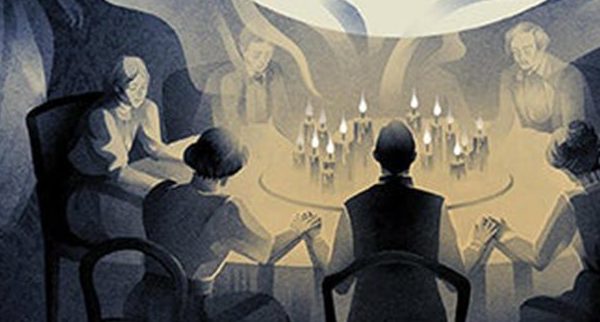Halloween season is approaching, and as the days get shorter, our thoughts inevitably turn to all things spooky. With that in mind, Gizmodo knew we wanted to speak with Marc Hartzman, author of the brand-new nonfiction release Chasing Ghosts: A Tour of Our Fascination With Spirits and the Supernatural.
Chasing Ghosts delves into the history of humanity’s belief in, you guessed it, ghosts. It also looks at how people have attempted to pierce the veil and make contact with the departed over the years — and how, just as often, sceptics have set out to debunk their paranormal claims. What follows is a lightly edited and condensed version of our phone conversation with Hartzman.
Cheryl Eddy, Gizmodo: You’ve written several books on offbeat topics (weird things found on eBay, sideshow performers, the strange history of Mars, and our obsession with Mars). What led you to ghosts as your next subject?
Marc Hartzman: Well, it definitely falls into that world of the bizarre. As you can tell, I really love these offbeat fringe topics. I do a site called Weird Historian, which is full of different kinds of stories. Lots of stories about the paranormal there. I’ve just always loved this kind of thing — I’ve been into the strange and unusual since I was a kid.
So ghosts were part of that, and then there’s a couple other things I suppose that are connected to it. One is, I’ve always had this sort of fear and concern about death — not, I guess, about death specifically, but more about how it’s handled, and burial, and if burial is the wrong thing to do. Like, what if it’s a big mistake, and our souls are all trapped, still have some consciousness, but we can’t do anything about it because we’re stuck in a box six feet underground? That’s always been a bit worrisome. [Laughs.] I wrote another book called The Embalmed Head of Oliver Cromwell: A Memoir, that kind of touches on that subject a little bit. But just that thought of “Is there survival, does our consciousness live on?”, is always something I’ve been curious about.
Over the past several years I’ve really gotten into the spiritualism movement from the late 1800s and early 1900s, just collecting a bunch of books from that era, reading a bunch of stories, and writing articles for Weird Historian — it’s just such a fascinating time. It’s funny because you might look at my last book, The Big Book of Mars, and this one’s Chasing Ghosts and think there’s no connection, but there’s actually a lot of connection in my mind. One of those is that it’s kind of in the same era of the late 1800s, early 1900s, that turn-of-the-century Victorian type of era.
There were all these amazing things going on and different types of beliefs, and new technologies where all sorts of new things suddenly seemed possible. That must have been an interesting time! The same thing was going on with spiritualism — you have millions of people who were believers, thinking that we could absolutely communicate with the dead.
It wasn’t even a question, it was like, “Yep, now we know! There’s definitely life after death and this is what people are saying about it.” You had all these mediums popping up all over, producing these amazing effects, incredible manifestations that were incredibly believable to people. So I just found that whole era completely fascinating. The roots or the seeds of the book were always there, but the spiritualism movement really got me digging into it a lot more, and the book sort of branched off from there.

Gizmodo: Ghosts are obviously a broad topic and the book is broken into four distinct sections: ghosts or tales of the afterlife throughout history, the spiritualism movement, hauntings, and the relationship between technology and ghosts. Why did you decide to divide up the topic into those specific areas of focus?
Hartzman: I thought that covered a really good range, you know? I didn’t write the book in order; I started with spiritualism, and I think it’s important to show that it was by no means new, of course. Belief in ghosts and spirits, however you define it, goes all the way back to as long as there have been humans. I think it’s important to show the ancient cultures and what their beliefs were, and going through medieval times, purgatory, Christian beliefs — I find all these evolutions of it really fascinating, up to Swedenborgianism and different occultists and things like that. It all kind of leads into the modern spiritualism movement, up through Andrew Jackson Davis — who just preceded the Fox sisters, where things really kicked off in 1848.
There’s a little bit of overlap with spiritualism and technology because you get into, like, William Mumler, the first spirit photographer, I kind of separated him out into technology. That gave me a chance to tell another sort of branch of the world of ghosts, which is trying to capture them — whether they truly believed they were hunting them, or just profiting off people thinking they were capturing them, like the spirit photographers. But again the spirit photography kind of gets back into what I was saying before about new technologies and new beliefs and things that might be possible.
The camera comes out, and maybe it can see things we can’t, and why not believe that might be possible? It’s all-new, right? But then you get into Hereward Carrington, you know, all of his devices trying to detect ghosts and the people he was working with, right up through the stuff you see on every [ghost-hunting] TV show today with all kinds of equipment and ghost-detection machines. A lot of that kind of stems out of Ghostbusters: “Oh, you can use machines to capture ghosts?” That kind of sparks a new generation of ghost hunters.
I think all of those uses are really interesting, but it also kind of gave me a chance to explore a lot of science. The technology is interesting in what it might capture, and how it might help show that ghosts aren’t ghosts. Like how an EMF reader might not really detect a ghost but might detect why you thought you saw a ghost there. Because there’s this other thing going on, which is why these electromagnetic field levels were going off the charts — it’s actually because of this elevator bank behind a wall in an apartment building, to use one example a parapsychologist described to me in the book.
I also love the stories of “infrasounds” that Vic Tandy discovered in the late ‘70s and early ‘80s — he discovered this frequency at 18.9 Hz that was something that we don’t detect, but it affects the brain and like vibrates the eyeballs and makes people see shadowy figures and feel like there’s something paranormal going on. He discovers that this is going on in a haunted cathedral cellar from the 14th century. “Oh, there’s infrasound here? Maybe that’s explaining some of these feelings people are having.” By no means — and he said this as well — this is not explaining everything, but maybe it explains a few things, which is interesting.
So I kind of love that science solves some things, but not everything, and there’s still this whole world of mystery left even though we keep learning and keep advancing our technology. And I think you’ve gotta cover haunted places in a book about ghosts. There’s thousands of stories about haunted places, so then it becomes of mixture of trying to cover a balance of known stories and kind of digging deeper into them, and also covering stuff that might be lesser-known, trying to create a balance of unique stories of haunted places.

Gizmodo: For all the people in the book who claim to have seen or communicated with ghosts, there are just as many sceptics and debunkers, no matter what period of history you’re talking about. Why do you think that is?
Hartzman: It’s one of those things that we can’t prove. No one can prove survival of consciousness. No technology is going to capture that for sure. There’s no machine that’s going to tell us “Yes, this is definitive.” So I think that’s always going to leave people sceptical no matter what … during spiritualism, the biggest sceptics were magicians because they knew the kinds of tricks that people were employing. They wanted to expose these people. And more recently you have people like the late James Randi who would expose a lot of these things and was a huge sceptic.
There’s always going to be people who do believe it’s wrong, and they can often prove that there are frauds. That was Houdini’s big thing, he thought it was horrible what mediums were doing to people, taking their money under the guise of having them communicate with a lost loved one and taking advantage of their grief, and fooling them into something and stealing from them in that sense. He thought that was wrong.
Whereas in his mind, he said that if you come to a magician’s show, and you pay for the ticket, there’s an understanding between us that what you’re seeing is an illusion. It’s a different relationship with the audience than a medium would have — so I think there’s also maybe justice involved, to some degree, when it comes to that.
Gizmodo: Are you a sceptic or believer, and did working on this book change your point of view?
Hartzman: That’s kind of a tough question. I would say I’m more of a believer than a sceptic, but I’m not 100% sold. I would say that working on the book did change my perspective a bit, and I would say it pushed me a bit more towards a believer. Part of that’s just because there’s a bunch of stories in the book where there’s sceptics that explain things well, and obviously there’s magicians who’ve explained different tricks from mediums. A lot of stuff comes out like, “Oh that’s how they did it? That’s all they were doing?” Or like “Oh, it’s infrasound.”
But then there’s all these great examples, I think, in the book, of “I don’t know how you explain that.” Some of these things just seem really hard to explain. Some of those came from friends who I’d talk to about the book and they’d say, “I have a ghost story,” and all these amazing stories came out about things that just don’t seem to make a lot of sense. There’s things like that that leave you kind of wondering, and you don’t really know how to explain them.
I also think it’s much more fun to believe than not. It’s fun to believe and to hope. There’s something nice about that. I look at it like, “Wow, you saw a ghost!” That should be an exciting moment! [You] now know that there’s something else, and that should bring great peace, knowing that when [you] die, it’s not just over and you’re not just a mass that gets dumped into a box and fed to worms or something. That’s comforting! I think there’s enough stories that make me think that there’s something to it still, and I prefer to believe that.
Chasing Ghosts: A Tour of Our Fascination With Spirits and the Supernatural by Marc Hartzman is out on September 28. You can pre-order a copy here.
